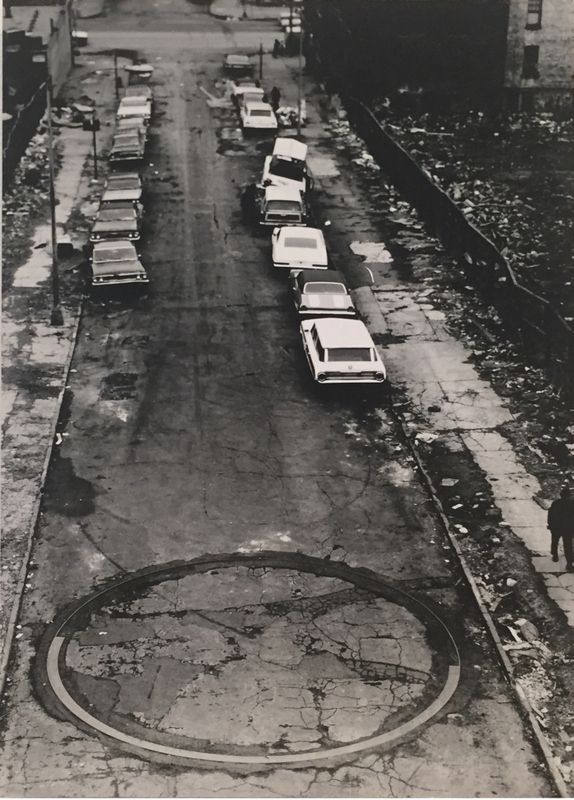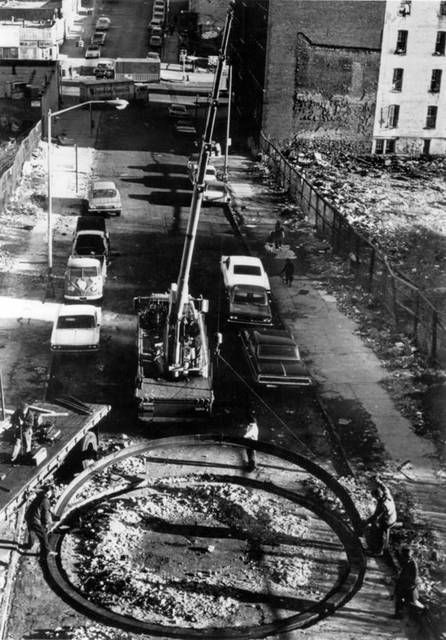Last-Minute NYC Holiday Gift Guide 🎁
We’ve created a holiday gift guide with presents for the intrepid New Yorker that should arrive just in time—



Richard Serra’s “To Encircle Base Plate Hexagram, Right Angles Inverted,” in the Bronx. Photo by Peter Moore © The Estate of Gordon Matta-Clark. Courtesy The Estate of Gordon Matta-Clark and David Zwirner, New York/London/Hong Kong
Richard Serra is known for his large, sheet metal installations. But did you know his first major outdoor exhibition, To Encircle Base Plate Hexagon, Right Angles Inverted, was located at 183rd Street and Webster Avenue in the Bronx? According to an interview with David Crimp, in 1970, Serra approached the New York City Park Administration about creating his first installation somewhere in the city. They simply replied, “Manhattan is out. Try the Bronx.”
Towards the end of the 1960s, Serra was moving out of indoor art institutions and was seeking to work with outdoor spaces. As an urbanist, he did not want to create works in rural, unpopulated areas, finding them isolating and unfulfilling. He also felt that working on a park or a corporate plaza would innately change the connotation of the piece, automatically affiliating it with its surroundings. In the interview with Crimp, Serra said that he “would rather be vulnerable and deal with the reality of my living situation.”
Thus, in 1970, he negotiated with the City’s Park Administration to install a piece in New York. The Administration told him that for $250, they would give him a permit to work on a street in the Bronx. The site they landed on was a down-trodden, dead-end on 183rd Street. Serra described the location as “sinister, used by local criminals to torch cars they had stolen.”

Installation in 1970, at 183rd Street and Webster Avenue, in the Bronx, New York. Photo: Peter Moore. © The Estate of Gordon Matta-Clark. Courtesy The Estate of Gordon Matta-Clark and David Zwirner, New York/London/Hong Kong
Serra pressed on nonetheless and created To Encircle Base Plate Hexagon, Right Angles Inverted, an idea he had first begun working on in Ueno Park, Japan. According to the book, On the Museum Ruins, by Douglas Crimp and Louise Lawler, the installation was a 26 feet in diameter, sheet metal circle, embedded in the surface of the street. From certain angles, especially from a distance, you could hardly even see the installation was there. Yet, as the viewer came closer, the installation emerged and from a nearby set of stairs, one could even look down on the piece.
Ultimately, To Encircle did not quite fulfill Serra’s hopes for a work within an urban space. He fundamentally felt that a sculpture can only truly be appreciated in its actual environment – and art critics at the time were not interested in heading to a derelict street in the Bronx to experience the work. Moreover, Bronx residents, whom Serra had described as “local criminals,” were also not flocking to check out the installation. Thus, ironically, his first major outdoor piece was left as isolated in an urban setting as it may have been in a rural area. Yet, Serra’s work has often has had such uncelebrated ends – we visited the highly contentious piece Clara Clara sitting outside an art restoration facility in the industrial suburb of Paris, while another piece was in a lot in the Bronx.
Another interesting point that the website 16 Miles of String addressed is how and why New York City allowed Serra to shut down an entire street to create this installation. Taking a look at the present-day site, 16 Miles came to the conclusion that at the time Serra was permitted to rip up the street, the city was most likely already planning to build the housing project, Twin Parks West Houses on that block. Thus, “[To Encircle] could only exist because the city had decided that the neighborhood was in need of publicly funded improvement.”
To Encircle still received critical acclaim – it was cataloged in both the 1970 Whitney Annual and the 1971 Guggenheim International, and is part of a photo series about Serra’s work at the Guggenheim in Bilbao. However, for Serra, it was mainly a disappointment. The installation is now held at the St. Louis Art Museum.
For more on Richard Serra’s work, click here. Next, read about his most recent exhibit, Equal, in David Zwirner Gallery in Chelsea.
Subscribe to our newsletter